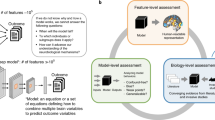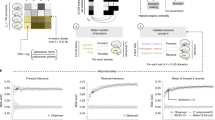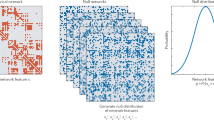Abstract
Perhaps one of the greatest scientific challenges is to understand the human brain. Here we review current methods in human neuroscience, highlighting the ways that they have been used to study the neural bases of the human mind. We begin with a consideration of different levels of description relevant to human neuroscience, from molecules to large-scale networks, and then review the methods that probe these levels and the ability of these methods to test hypotheses about causal mechanisms. Functional MRI is considered in particular detail, as it has been responsible for much of the recent growth of human neuroscience research. We briefly review its inferential strengths and weaknesses and present examples of new analytic approaches that allow inferences beyond simple localization of psychological processes. Finally, we review the prospects for real-world applications and new scientific challenges for human neuroscience.
This is a preview of subscription content, access via your institution
Access options
Subscribe to this journal
Receive 51 print issues and online access
$199.00 per year
only $3.90 per issue
Buy this article
- Purchase on Springer Link
- Instant access to full article PDF
Prices may be subject to local taxes which are calculated during checkout




Similar content being viewed by others
References
Buckholtz, J. W. et al. Dopaminergic network differences in human impulsivity. Science 329, 532 (2010)
Plichta, M. M. & Scheres, A. Ventral-striatal responsiveness during reward anticipation in ADHD and its relation to trait impulsivity in the healthy population: a meta-analytic review of the fMRI literature. Neurosci. Biobehav. Rev. 38, 125–134 (2014)
Schilling, C. et al. Common structural correlates of trait impulsiveness and perceptual reasoning in adolescence. Hum. Brain Mapp. 34, 374–383 (2013)
Legon, W. et al. Transcranial focused ultrasound modulates the activity of primary somatosensory cortex in humans. Nature Neurosci. 17, 322–329 (2014)
Chamberlain, S. R., Müller, U., Robbins, T. W. & Sahakian, B. J. Neuropharmacological modulation of cognition. Curr. Opin. Neurol. 19, 607–612 (2006)
Parvizi, J. et al. Electrical stimulation of human fusiform face-selective regions distorts face perception. J. Neurosci. 32, 14915–14920 (2012)This study uses the combination of fMRI and intracranial electrical stimulation to demonstrate the causal role of fusiform regions in face perception
Chen, A. C. et al. Causal interactions between fronto-parietal central executive and default-mode networks in humans. Proc. Natl Acad. Sci. USA 110, 19944–19949 (2013)
Bandettini, P. A. Twenty years of functional MRI: the science and the stories. Neuroimage 62, 575–588 (2012)
Logothetis, N. K., Pauls, J., Augath, M., Trinath, T. & Oeltermann, A. Neurophysiological investigation of the basis of the fMRI signal. Nature 412, 150–157 (2001)
Attwell, D. et al. Glial and neuronal control of brain blood flow. Nature 468, 232–243 (2010)
Hillman, E. M. C. Coupling mechanism and significance of the bold signal: a status report. Annu. Rev. Neurosci. 37, 161–181 (2014)
Sirotin, Y. B. & Das, A. Anticipatory haemodynamic signals in sensory cortex not predicted by local neuronal activity. Nature 457, 475–479 (2009)
Thomsen, K., Offenhauser, N. & Lauritzen, M. Principal neuron spiking: neither necessary nor sufficient for cerebral blood flow in rat cerebellum. J. Physiol. (Lond.) 560, 181–189 (2004)
Einevoll, G. T., Kayser, C., Logothetis, N. K. & Panzeri, S. Modelling and analysis of local field potentials for studying the function of cortical circuits. Nature Rev. Neurosci. 14, 770–785 (2013)
Farah, M. J. Brain images, babies, and bathwater: critiquing critiques of functional neuroimaging. Hastings Cent. Rep. 44, S19–S30 (2014)
Poldrack, R. A. & Yarkoni, T. From brain maps to cognitive ontologies: informatics and the search for mental structure. Annu. Rev. Psychol http://dx.doi.org/10.1146/annurev-psych-122414-033729 (2015)
Norman, K. A., Polyn, S. M., Detre, G. J. & Haxby, J. V. Beyond mind-reading: multi-voxel pattern analysis of fMRI data. Trends Cogn. Sci. 10, 424–430 (2006)
Kriegeskorte, N., Mur, M. & Bandettini, P. Representational similarity analysis—connecting the branches of systems neuroscience. Frontiers Syst Neurosci 2, 4 (2008)
Naselaris, T., Prenger, R. J., Kay, K. N., Oliver, M. & Gallant, J. L. Bayesian reconstruction of natural images from human brain activity. Neuron 63, 902–915 (2009)
Cowen, A. S., Chun, M. M. & Kuhl, B. A. Neural portraits of perception: reconstructing face images from evoked brain activity. Neuroimage 94, 12–22 (2014)
Mitchell, T. M. et al. Predicting human brain activity associated with the meanings of nouns. Science 320, 1191–1195 (2008)An outstanding example of the use of fMRI along with a model of word meaning derived from a large text corpus to predict activation patterns associated with words
Huth, A. G., Nishimoto, S., Vu, A. T. & Gallant, J. L. A continuous semantic space describes the representation of thousands of object and action categories across the human brain. Neuron 76, 1210–1224 (2012)
Sprague, T. C., Saproo, S. & Serences, J. T. Visual attention mitigates information loss in small- and large-scale neural codes. Trends Cogn. Sci. 19, 215–226 (2015)
Lewis-Peacock, J. A. & Norman, K. A. Competition between items in working memory leads to forgetting. Nature Commun. 5, 5768 (2014)
Charest, I., Kievit, R. A., Schmitz, T. W., Deca, D. & Kriegeskorte, N. Unique semantic space in the brain of each beholder predicts perceived similarity. Proc. Natl Acad. Sci. USA 111, 14565–14570 (2014)
Davis, T. & Poldrack, R. A. Quantifying the internal structure of categories using a neural typicality measure. Cereb. Cortex 24, 1720–1737 (2014)
Mack, M. L., Preston, A. R. & Love, B. C. Decoding the brain’s algorithm for categorization from its neural implementation. Curr. Biol. 23, 2023–2027 (2013)
Xue, G. et al. Greater neural pattern similarity across repetitions is associated with better memory. Science 330, 97–101 (2010)
Kriegeskorte, N. et al. Matching categorical object representations in inferior temporal cortex of man and monkey. Neuron 60, 1126–1141 (2008)This paper applies representational similarity analysis to human fMRI and monkey electrophysiology data to demonstrate similar representational spaces in the inferior temporal cortex across species
Wager, T. D. et al. An fMRI-based neurologic signature of physical pain. N. Engl. J. Med. 368, 1388–1397 (2013)
Davis, T. et al. What do differences between multi-voxel and univariate analysis mean? How subject-, voxel-, and trial-level variance impact fMRI analysis. Neuroimage 97, 271–283 (2014)
Todd, M. T., Nystrom, L. E. & Cohen, J. D. Confounds in multivariate pattern analysis: theory and rule representation case study. Neuroimage 77, 157–165 (2013)
Dubois, J., de Berker, A. O. & Tsao, D. Y. Single-unit recordings in the macaque face patch system reveal limitations of fMRI MVPA. J. Neurosci. 35, 2791–2802 (2015)
Schultz, W. Predictive reward signal of dopamine neurons. J. Neurophysiol. 80, 1–27 (1998)
McClure, S. M., Berns, G. S. & Montague, P. R. Temporal prediction errors in a passive learning task activate human striatum. Neuron 38, 339–346 (2003)
O’Doherty, J. P., Dayan, P., Friston, K., Critchley, H. & Dolan, R. J. Temporal difference models and reward-related learning in the human brain. Neuron 38, 329–337 (2003)
Badre, D. & Frank, M. J. Mechanisms of hierarchical reinforcement learning in cortico-striatal circuits 2: evidence from fMRI. Cereb. Cortex 22, 527–536 (2012)
Daw, N. D., Gershman, S. J., Seymour, B., Dayan, P. & Dolan, R. J. Model-based influences on humans’ choices and striatal prediction errors. Neuron 69, 1204–1215 (2011)
LaRocque, K. F. et al. Global similarity and pattern separation in the human medial temporal lobe predict subsequent memory. J. Neurosci. 33, 5466–5474 (2013)
Raichle, M. E. The brain’s default mode network. Annu. Rev. Neurosci. 38, 433–447 (2015)
Shulman, G. L. et al. Common blood flow changes across visual tasks: II. decreases in cerebral cortex. J. Cogn. Neurosci. 9, 648–663 (1997)
Greicius, M. D., Krasnow, B., Reiss, A. L. & Menon, V. Functional connectivity in the resting brain: a network analysis of the default mode hypothesis. Proc. Natl Acad. Sci. USA 100, 253–258 (2003)
Vincent, J. L. et al. Intrinsic functional architecture in the anaesthetized monkey brain. Nature 447, 83–86 (2007)
Becerra, L., Pendse, G., Chang, P.-C., Bishop, J. & Borsook, D. Robust reproducible resting state networks in the awake rodent brain. PLoS ONE 6, e25701 (2011)
Buckner, R. L. et al. Molecular, structural, and functional characterization of Alzheimer’s disease: evidence for a relationship between default activity, amyloid, and memory. J. Neurosci. 25, 7709–7717 (2005)This paper presents a multimodal analysis implicating the default mode network in cognitive decline associated with Alzheimer disease
Smith, S. M. et al. Correspondence of the brain’s functional architecture during activation and rest. Proc. Natl Acad. Sci. USA 106, 13040–13045 (2009)This paper demonstrates that resting state networks are systematically associated with cognitive functions
Laumann, T. O. et al. Functional system and areal organization of a highly-sampled individual human brain. Neuron 87, 657–670 (2015)
Murphy, K., Birn, R. M. & Bandettini, P. A. Resting-state fMRI confounds and cleanup. Neuroimage 80, 349–359 (2013)
Power, J. D., Schlaggar, B. L. & Petersen, S. E. Recent progress and outstanding issues in motion correction in resting state fMRI. Neuroimage 105, 536–551 (2015)
Tagliazucchi, E. & Laufs, H. Decoding wakefulness levels from typical fMRI resting-state data reveals reliable drifts between wakefulness and sleep. Neuron 82, 695–708 (2014)
Morcom, A. M. & Fletcher, P. C. Does the brain have a baseline? Why we should be resisting a rest. Neuroimage 37, 1073–1082 (2007)
Nestler, E. J. & Hyman, S. E. Animal models of neuropsychiatric disorders. Nature Neurosci. 13, 1161–1169 (2010)
Insel, T. R. The NIMH research domain criteria (RDoC) project: precision medicine for psychiatry. Am. J. Psychiatry 171, 395–397 (2014)
Mayberg, H. S. Targeted electrode-based modulation of neural circuits for depression. J. Clin. Invest. 119, 717–725 (2009)
Sulzer, J. et al. Real-time fMRI neurofeedback: progress and challenges. Neuroimage 76, 386–399 (2013)
Goodkind, M. et al. Identification of a common neurobiological substrate for mental illness. JAMA Psychiatry 72, 305–315 (2015)This paper examines a large structural imaging dataset and finds that brain abnormalities linked to mental illness are shared across diagnostic categories
Schizophrenia Working Group of the Psychiatric Genomics Consortium. Biological insights from 108 schizophrenia-associated genetic loci. Nature 511, 421–427 (2014)
Sperling, R. A., Karlawish, J. & Johnson, K. A. Preclinical Alzheimer disease-the challenges ahead. Nature Rev. Neurol. 9, 54–58 (2013)
Owen, A. M. Detecting consciousness: a unique role for neuroimaging. Annu. Rev. Psychol. 64, 109–133 (2013)
Ariely, D. & Berns, G. S. Neuromarketing: the hope and hype of neuroimaging in business. Nature Rev. Neurosci. 11, 284–292 (2010)
Berns, G. S. & Moore, S. A neural predictor of cultural popularity. J. Consum. Psychol. 22, 154–160 (2012)
Falk, E. B., Berkman, E. T. & Lieberman, M. D. From neural responses to population behavior: neural focus group predicts population-level media effects. Psychol. Sci. 23, 439–445 (2012)
Gabrieli, J. D. E., Ghosh, S. S. & Whitfield-Gabrieli, S. Prediction as a humanitarian and pragmatic contribution from human cognitive neuroscience. Neuron 85, 11–26 (2015)
Morse, S. J. Brain overclaim syndrome and criminal responsibility: A diagnostic note. Ohio State J. Criminal Law 3, 397–412 (2006)
Jones, O. D., Wagner, A. D., Faigman, D. L. & Raichle, M. E. Neuroscientists in court. Nature Rev. Neurosci. 14, 730–736 (2013)
Farah, M. J., Hutchinson, J. B., Phelps, E. A. & Wagner, A. D. Functional MRI-based lie detection: scientific and societal challenges. Nature Rev. Neurosci. 15, 123–131 (2014)
Reardon, S. Neuroscience in court: the painful truth. Nature 518, 474–476 (2015)
Underwood, E. DARPA aims to rebuild brains. Science 342, 1029–1030 (2013)
Gerits, A. et al. Optogenetically induced behavioral and functional network changes in primates. Curr. Biol. 22, 1722–1726 (2012)
Insel, T. R., Landis, S. C. & Collins, F. S. The NIH Brain Initiative. Science 340, 687–688 (2013)
Moeller, S. et al. Multiband multislice GE-EPI at 7 tesla, with 16-fold acceleration using partial parallel imaging with application to high spatial and temporal whole-brain fMRI. Magn. Reson. Med. 63, 1144–1153 (2010)
Yacoub, E., Harel, N. & Ugurbil, K. High-field fMRI unveils orientation columns in humans. Proc. Natl Acad. Sci. USA 105, 10607–10612 (2008)
Magnain, C. et al. Optical coherence tomography visualizes neurons in human entorhinal cortex. Neurophotonics 2, 015004 (2015)A demonstration of the power of optical coherence tomography to image neural structure in ex vivo human brain tissue
Hawrylycz, M. J. et al. An anatomically comprehensive atlas of the adult human brain transcriptome. Nature 489, 391–399 (2012)
Richiardi, J. et al. Correlated gene expression supports synchronous activity in brain networks. Science 348, 1241–1244 (2015)
Van Essen, D. C. et al. The WU-Minn Human Connectome Project: an overview. Neuroimage 80, 62–79 (2013)This paper presents a broad overview of the Human Connectome Project
Saygin, Z. M. et al. Tracking the roots of reading ability: white matter volume and integrity correlate with phonological awareness in prereading and early-reading kindergarten children. J. Neurosci. 33, 13251–13258 (2013)
Van Essen, D. C. et al. Mapping Connections in Humans and Non-human Primates: Aspirations and Challenges for Diffusion Imaging 2nd edn, Ch. 16 (Elsevier, 2013)
Eveley, C. et al. Superficial white matter fiber systems impede detection of long-range cortical connections in diffusion MR tractography. Proc. Natl Acad. Sci. USA 112, E2820–E2828 (2015)
Smith, S. M. et al. Network modelling methods for fMRI. Neuroimage 54, 875–891 (2011)
Honey, C. J. et al. Predicting human resting-state functional connectivity from structural connectivity. Proc. Natl Acad. Sci. USA 106, 2035–2040 (2009)
Shen, K. et al. Information processing architecture of functionally defined clusters in the macaque cortex. J. Neurosci. 32, 17465–17476 (2012)
Yarkoni, T., Poldrack, R. A., Nichols, T. E., Van Essen, D. C. & Wager, T. D. Large-scale automated synthesis of human functional neuroimaging data. Nature Methods 8, 665–670 (2011)
Ioannidis, J. P. A. Why most published research findings are false: author’s reply to Goodman and Greenland. PLoS Med. 4, e215 (2007)
Button, K. S. et al. Power failure: why small sample size undermines the reliability of neuroscience. Nature Rev. Neurosci. 14, 365–376 (2013)
Carp, J. On the plurality of (methodological) worlds: estimating the analytic flexibility of fMRI experiments. Frontiers Neurosci 6, 149 (2012)
Kriegeskorte, N., Simmons, W. K., Bellgowan, P. S. F. & Baker, C. I. Circular analysis in systems neuroscience: the dangers of double dipping. Nature Neurosci. 12, 535–540 (2009)
Stein, J. L. et al. Identification of common variants associated with human hippocampal and intracranial volumes. Nature Genet. 44, 552–561 (2012)This paper presents the first well-powered genome-wide association study of brain structure
Waskom, M. L., Kumaran, D., Gordon, A. M., Rissman, J. & Wagner, A. D. Frontoparietal representations of task context support the flexible control of goal-directed cognition. J. Neurosci. 34, 10743–10755 (2014)
Irimia, A., Chambers, M. C., Torgerson, C. M. & Van Horn, J. D. Circular representation of human cortical networks for subject and population-level connectomic visualization. Neuroimage 60, 1340–1351 (2012)
Blokland, G. A. M. et al. Heritability of working memory brain activation. J. Neurosci. 31, 10882–10890 (2011)
Glahn, D. C. et al. Genetic control over the resting brain. Proc. Natl Acad. Sci. USA 107, 1223–1228 (2010)
Barnett, J. H., Scoriels, L. & Munafò, M. R. Meta-analysis of the cognitive effects of the catechol-O-methyltransferase gene Val158/108Met polymorphism. Biol. Psychiatry 64, 137–144 (2008)
Nickl-Jockschat, T., Janouschek, H., Eickhoff, S. B. & Eickhoff, C. R. Lack of meta-analytic evidence for an impact of COMT Val158Met genotype on brain activation during working memory tasks. Biol. Psychiatry http://dx.doi.org/10.1016/j.biopsych.2015.02.030 (2015)
Farah, M. J. Neuroethics: the ethical, legal, and societal impact of neuroscience. Annu. Rev. Psychol. 63, 571–591 (2012)
Illes, J. & Racine, E. Imaging or imagining? A neuroethics challenge informed by genetics. Am. J. Bioeth. 5, 5–18 (2005)
Farah, M. J. & Gillihan, S. J. The puzzle of neuroimaging and psychiatric diagnosis: technology and nosology in an evolving discipline. AJOB Neurosci. 3, 31–41 (2012)
Conrad, P. The Medicalization of Society: On the Transformation of Human Conditions into Treatable Disorders (Johns Hopkins Univ. Press, 2007)
Sahakian, B. & Morein-Zamir, S. Professor’s little helper. Nature 450, 1157–1159 (2007)
Fitz, N. S. & Reiner, P. B. The challenge of crafting policy for do-it-yourself brain stimulation. J. Med. Ethics 41, 410–412 (2015)
Horvath, J. C., Forte, J. D. & Carter, O. Quantitative review finds no evidence of cognitive effects in healthy populations from single-session transcranial direct current stimulation (tDCS). Brain Stimul. 8, 535–550 (2015)
Acknowledgements
Thanks to I. Eisenberg, D. Glahn, R. Raizada, and M. Shine for comments on an earlier draft of this manuscript, and N. Logothetis for helpful discussions.
Author information
Authors and Affiliations
Contributions
R.P. and M.F. planned and wrote the paper.
Corresponding author
Ethics declarations
Competing interests
The authors declare no competing financial interests.
Rights and permissions
About this article
Cite this article
Poldrack, R., Farah, M. Progress and challenges in probing the human brain. Nature 526, 371–379 (2015). https://doi.org/10.1038/nature15692
Received:
Accepted:
Published:
Issue Date:
DOI: https://doi.org/10.1038/nature15692
This article is cited by
-
Testing cognitive theories with multivariate pattern analysis of neuroimaging data
Nature Human Behaviour (2023)
-
Mobile cognition: imaging the human brain in the ‘real world’
Nature Reviews Neuroscience (2023)
-
A mesocorticolimbic signature of pleasure in the human brain
Nature Human Behaviour (2023)
-
Individual Variability of Broca’s Area of the Brain in Women
Bulletin of Experimental Biology and Medicine (2023)
-
How Do Regulatory Focus and the Big Five Relate to Work-domain Risk-taking? Evidence from Resting-state fMRI
Journal of Business and Psychology (2023)
Comments
By submitting a comment you agree to abide by our Terms and Community Guidelines. If you find something abusive or that does not comply with our terms or guidelines please flag it as inappropriate.



